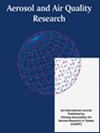Calibration of Low-cost Sensors for Measurement of Indoor Particulate Matter Concentrations via Laboratory/Field Evaluation
IF 2.5
4区 环境科学与生态学
Q3 ENVIRONMENTAL SCIENCES
引用次数: 0
Abstract
Recently, low-cost sensors (LCSs) have been widely used in monitoring particulate matter (PM) mass concentrations. Maintaining the accuracy of the sensors is important and requires rigorous calibration and performance evaluation. In this study, two commercial LCSs, Plantower PMS3003 and Plantower PMS7003, were evaluated in the laboratory and in the field using a reference-grade PM monitor (GRIMM 11-D). Laboratory evaluation was conducted with polystyrene latex (PSL) particles in a 1 m 3 chamber at 20 ° C with a relative humidity of 20%. Each LCS indicated higher mass concentrations than GRIMM 11-D for small-sized PSL particles (0.56 µ m); however, the LCSs indicated lower mass concentrations than GRIMM 11-D for PSL particles larger than 0.56 µ m. In addition, the difference in mass concentrations between the LCS and GRIMM 11-D became higher with particle sizes greater than 0.56 µ m. Nonetheless, a high correlation (R 2 > 0.9) between each LCS and GRIMM 11-D was obtained. Field evaluation was conducted at Yonsei University (Seoul, South Korea) from February 12 to March 31, 2022. The LCSs showed generally higher PM mass concentrations than GRIMM 11-D; however, some data points of the LCSs revealed different trends. We observed that outdoor PM 10 /PM 2.5 and relative humidity had notable impacts on the LCS data; in addition, LCS sensitivity depended on whether the PM concentration was low or high. Based on these observations, regression-based calibration models were constructed using the selected independent variables (outdoor PM 10 /PM 2.5 and relative humidity) after dividing the PM concentration into low and high sections. Consequently, the accuracy of the LCSs was significantly enhanced. Therefore, using LCSs with the calibration models can replace the use of expensive reference PM monitors, resulting in cost savings.通过实验室/现场评估校准用于测量室内颗粒物浓度的低成本传感器
近年来,低成本传感器(LCSs)在监测颗粒物(PM)质量浓度方面得到了广泛应用。保持传感器的准确性很重要,需要严格的校准和性能评估。在本研究中,使用参考级PM监测仪(GRIMM 11-D)在实验室和现场对两种商用lcs (Plantower PMS3003和Plantower PMS7003)进行了评估。实验室评估是用聚苯乙烯乳胶(PSL)颗粒在20°C、相对湿度20%的1 m 3的腔室中进行的。小尺寸PSL颗粒(0.56µm)的LCS质量浓度均高于GRIMM 11-D;粒径大于0.56µm的PSL粒子,LCS的质量浓度低于GRIMM 11-D,粒径大于0.56µm时,LCS与GRIMM 11-D的质量浓度差异增大,但各LCS与GRIMM 11-D的质量浓度具有较高的相关性(R 2 > 0.9)。现场评估于2022年2月12日至3月31日在延世大学(韩国首尔)进行。lcs的PM质量浓度普遍高于GRIMM 11-D;然而,最低收入国家的一些数据点显示出不同的趋势。室外PM 10 /PM 2.5和相对湿度对LCS数据有显著影响;此外,LCS的灵敏度取决于PM浓度的高低。在此基础上,选取独立变量(室外PM 10 /PM 2.5和相对湿度),将PM浓度划分为高低段,构建基于回归的定标模型。因此,lcs的精度显著提高。因此,使用lcs与校准模型可以取代使用昂贵的参考PM监视器,从而节省成本。
本文章由计算机程序翻译,如有差异,请以英文原文为准。
求助全文
约1分钟内获得全文
求助全文
来源期刊

Aerosol and Air Quality Research
ENVIRONMENTAL SCIENCES-
CiteScore
8.30
自引率
10.00%
发文量
163
审稿时长
3 months
期刊介绍:
The international journal of Aerosol and Air Quality Research (AAQR) covers all aspects of aerosol science and technology, atmospheric science and air quality related issues. It encompasses a multi-disciplinary field, including:
- Aerosol, air quality, atmospheric chemistry and global change;
- Air toxics (hazardous air pollutants (HAPs), persistent organic pollutants (POPs)) - Sources, control, transport and fate, human exposure;
- Nanoparticle and nanotechnology;
- Sources, combustion, thermal decomposition, emission, properties, behavior, formation, transport, deposition, measurement and analysis;
- Effects on the environments;
- Air quality and human health;
- Bioaerosols;
- Indoor air quality;
- Energy and air pollution;
- Pollution control technologies;
- Invention and improvement of sampling instruments and technologies;
- Optical/radiative properties and remote sensing;
- Carbon dioxide emission, capture, storage and utilization; novel methods for the reduction of carbon dioxide emission;
- Other topics related to aerosol and air quality.
 求助内容:
求助内容: 应助结果提醒方式:
应助结果提醒方式:


